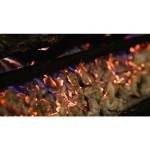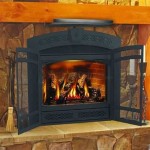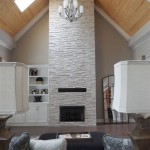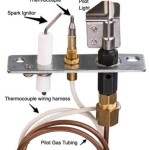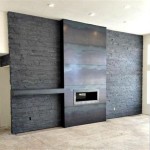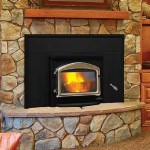How To Paint Your Fireplace Door
A fireplace door, often constructed of metal and glass, serves a functional and aesthetic purpose. Over time, the high heat and soot exposure can degrade the original factory finish, leading to rust, discoloration, and a generally worn appearance. Painting a fireplace door is a cost-effective way to revitalize its look and protect it from further deterioration. This process, while relatively straightforward, requires careful preparation, appropriate materials, and adherence to safety precautions to ensure a lasting and visually appealing result.
Before commencing the painting project, a thorough assessment of the fireplace door's condition is crucial. Note any existing rust, peeling paint, or damage to the glass. This initial evaluation will determine the extent of preparation required. A heavily rusted door will necessitate more rigorous cleaning and rust removal than one with simply faded paint. Identifying any areas requiring repair, such as loose hinges or damaged seals, is also essential at this stage.
Preparing the Fireplace Door for Painting
Adequate preparation is paramount for achieving a professional and durable paint finish. This stage involves removing the door, cleaning it thoroughly, addressing any rust or imperfections, and applying a primer. Skipping or inadequately performing any of these steps can compromise the adhesion and longevity of the new paint.
The first step is to detach the fireplace door from the fireplace. This usually involves unscrewing bolts or detaching clips. It is advisable to photograph the door's installation before removal to aid in reassembly later. Once the door is removed, place it on a protected work surface, such as a drop cloth or newspapers, in a well-ventilated area. The ventilation is essential for both safety and to promote proper paint drying.
Next, clean the door with a wire brush and a solution of soap and water. This will remove loose debris, soot, and dirt. For stubborn grime, a degreasing cleaner specifically designed for metal may be necessary. Rinse the door thoroughly with clean water and allow it to dry completely. This is crucial as any remaining moisture can interfere with paint adhesion and promote rust formation.
Inspect the metal surface for any signs of rust. If rust is present, remove it using a wire brush, sandpaper (various grits, starting with a coarser grit and finishing with a finer grit), or a chemical rust remover. A rotary tool with a rust-removal attachment can expedite this process, particularly for larger areas of rust. Ensure all rust is removed, leaving a clean and smooth metal surface. After rust removal, wipe the surface clean with a tack cloth to remove any residual particles.
Mask off any areas that should not be painted, such as the glass panels. Use painter's tape specifically designed for high temperatures, as standard painter's tape may melt or leave residue. Ensure the tape is firmly pressed down to prevent paint from bleeding underneath. Apply multiple layers of tape if necessary to achieve a clean and precise masking line.
Apply a high-heat primer specifically formulated for metal surfaces. This primer will provide a base for the paint to adhere to and will also offer additional rust protection. Apply the primer in thin, even coats, following the manufacturer's instructions. Allow the primer to dry completely before proceeding to the next step. Multiple thin coats are preferable to a single thick coat, as they are less likely to drip or run.
Selecting and Applying the Paint
The selection of the correct paint is critical for a successful fireplace door painting project. Standard paints are not designed to withstand the high temperatures generated by a fireplace and will likely blister, peel, or emit noxious fumes. Therefore, a high-heat paint specifically formulated for fireplace doors or stoves is essential.
High-heat paints are typically available in spray cans or brush-on formulations. Spray paints generally provide a smoother and more even finish, especially for intricate designs. When using spray paint, hold the can approximately 10-12 inches from the surface and apply thin, even coats, overlapping each pass slightly. Avoid applying too much paint in one area, as this can lead to runs and drips.
If using a brush-on paint, choose a high-quality brush designed for use with metal paints. Apply the paint in thin, even coats, working in the direction of the metal grain. Avoid excessive brushing, as this can create brushstrokes that will be visible in the final finish. Allow each coat to dry completely before applying the next. Multiple thin coats are preferable to a single thick coat, as they will provide better adhesion and durability.
Regardless of the application method, follow the manufacturer's instructions regarding drying time between coats and the total number of coats recommended. Proper drying time is crucial for the paint to cure properly and achieve its maximum heat resistance. Typically, two to three coats of high-heat paint are sufficient for adequate coverage and protection.
Reassembly and Post-Painting Care
Once the paint is completely dry, carefully remove the painter's tape. Use a sharp utility knife to score along the edge of the tape before removal to prevent the paint from chipping. Inspect the painted surface for any imperfections, such as runs or drips. If necessary, lightly sand these areas with fine-grit sandpaper and apply a touch-up coat of paint.
Reattach the fireplace door to the fireplace using the photograph taken during the removal process as a guide. Ensure all bolts or clips are securely fastened. Inspect the gasket around the door frame to ensure it is in good condition and provides a tight seal. Replace the gasket if it is damaged or worn, as a proper seal is essential for efficient fireplace operation.
Allow the paint to cure completely before using the fireplace. Refer to the paint manufacturer's instructions for the recommended curing time, which can range from several hours to several days. During the initial use of the fireplace after painting, monitor the door closely for any signs of blistering or peeling paint. If any issues arise, discontinue use and contact a professional for assistance.
To maintain the painted fireplace door, regularly clean it with a soft cloth and a mild detergent. Avoid using abrasive cleaners or scouring pads, as these can damage the paint finish. Periodically inspect the door for any signs of rust or damage and address them promptly to prevent further deterioration. With proper care and maintenance, a freshly painted fireplace door can provide years of aesthetic appeal and protection.

Fireplace Door Update With Spray Paint Roots Wings Furniture Llc

Fireplace Door Update With Spray Paint Roots Wings Furniture Llc

How To Update Fireplace Brass

How To Spray Paint A Brass Fireplace Insert Erfly House

How To Paint Metal Fireplace Surround Four Generations One Roof

How To Spray Paint A Brass Fireplace Insert Erfly House

How To Paint A Brick Fireplace The Right Way

How To Refinish Rusted Fireplace Doors

Brass Fireplace Update East Coast Creative

Fireplace Door Update With Spray Paint Roots Wings Furniture Llc
Related Posts

